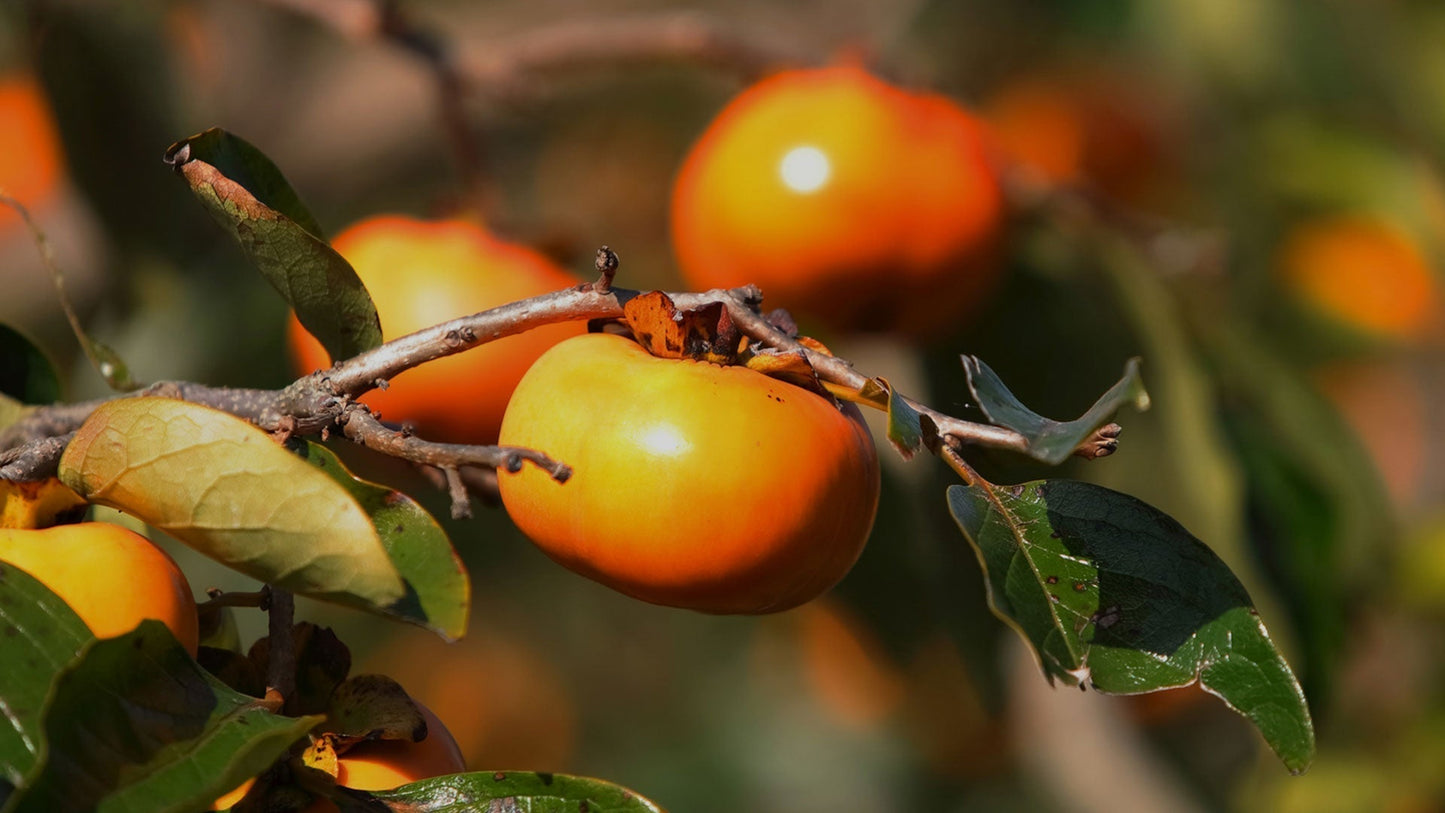
As the maple leaves ignite in brilliant oranges and reds across the landscape, the crisp air signals farmers to harvest fall fruit from Japan. Perhaps more than any other traditional autumn treat, nothing excites the Japanese palate quite like a perfectly ripe persimmon (also known as Japanese Kaki). In fact, the persimmon is the national fruit of Japan!
These delightfully sweet orange delicacies have been a major part of Japanese traditional food culture for hundreds of years. Japanese autumn fruits include grapes, apples and pears, but persimmons have the strongest connection to the fall season. You can find persimmons in everything from Japanese poetry to paintings to songs invoking the beauty of autumn.
The Role of Persimmons in Japanese Culture
Believed to be brought over from China over a thousand years ago, now, it’s said that there are over 1000 varieties of persimmon in Japan, each with its unique flavor profile.
As well as being a delicious delicacy originally enjoyed only by aristocrats, persimmons have long served a variety of purposes in Japanese culture. The raw materials from persimmon trees and the fruit’s juices have been used for things like wood sealant, construction, traditional Japanese craft and herbal teas. In some areas like Nara Prefecture, “Kakinoha Sushi” or sushi wrapped in Japanese Kaki leaves has become a popular local specialty.
Many regions associate persimmon trees with spirits. Some families will hang strings of dried persimmons in their homes for good luck and longevity on New Year’s Eve.
And of course, persimmons fulfill their most important role to date in modern Japanese culture: a delicious autumn snack and the most celebrated fall fruit from Japan.
Astringent vs Non-Astringent Japanese Persimmons
Persimmons can be categorized into two main types: “astringent” and “non-astringent” persimmons. It’s crucial to know the difference when you buy persimmons online.
Astringent means to have a slightly acidic or bitter taste, and that’s exactly how it applies to persimmon varieties. The label is also a clue as to when it’s best to eat your variety of choice.
Non-astringent persimmons, called “Ama-gaki” are squat, round and slightly flattened in shape. These persimmons are sweet and juicy the moment they’re picked from the trees. You can bite straight into these fruits for a crisp, refreshing experience. Popular examples of non-astringent varieties include the Taishu persimmon and Fuyu persimmon.

On the other hand, Astringent persimmons called “Shibu-gaki” are slightly elongated and acorn-like in shape. These persimmons require a little patience. Once harvested from the trees, they’re not quite ready to be eaten. You will need to wait for it to dry and become soft. Hachiya is a well-known example of an astringent persimmon variety.
Hachiya persimmons, known for their astringency, can be transformed into a delightful treat by naturally removing their bitterness. The key is to dry the persimmons until they become soft and extremely ripe. Once they reach this stage, they are perfect to enjoy. You can use a spoon to scoop the flesh. Hachiya persimmons are often used in the traditional practice of making "Hoshi-gaki" or dried persimmons and they’re treated to a life in the lap of luxury. After being hung out to dry and forming new skin, they are peeled and then treated to daily massages for at least a month to unleash their deep flavor potential. Dried persimmons offer a remarkable taste experience, characterized by an intense and concentrated sweetness. Some even detect a subtle hint of cinnamon. These dried Japanese Kaki are considered gourmet treats and are available from master Japanese craftsmen.
Which Type of Japanese Kaki Should You Try First?
If you’re sold on the idea of Japanese Seasonal Kaki Fruit but aren’t sure where to start, here is a brief introduction to some of our favorite varieties perfect for anyone trying to buy persimmons online.
Taishu Persimmons
Ephemeral with honey-like juices and unforgettably sweet and crispy flesh, Taishu persimmons are only available for a brief harvest of 3 weeks every fall. They are grown under meticulous conditions, with every plant only allowed a certain number of leaves and flowers to optimize the fruit’s flavoring. Everything from their sugar content to their size, to their colors are monitored closely to ensure every specimen is worthy of appearing at the market. Be sure to seize the opportunity to experience Taishu persimmons when they’re in season in early October!
Fuyu Persimmons
These ancient delicacies enjoy a well-deserved love from Japanese people and international fruit connoisseurs alike. When eaten fresh, these persimmons are sweet with hints of cinnamon and honey, the Fuyu persimmons from Ikigai Fruits are grown in Gifu Prefecture. This region is a land of clear streams where every fruit is meticulously cared for.

Fuyu persimmons can be enjoyed at various stages of ripeness growth depending on a person’s unique palate. For a crispy texture with refreshing sweetness, these persimmons can be refrigerated for a short time to enhance their natural flavors. For a melt-in-your-mouth, sugary dream come true, allow them to ripen for a few extra days at room temperature. Fuyu persimmons are in season from October to January, and can be purchased here.
Japanese Seasonal Kaki Fruit: A Symbol of Autumn's Gems
Persimmons are the perfect fall food to add to any fruit basket, dessert or dinner table. Their striking orange coloring and a wide variety of flavors make them a stand-out in every dish, especially for people who are unfamiliar with their full culinary potential. Japanese culture has celebrated these delicious, heavenly fruits for thousands of years, and we’re proud to share the amazing potential of persimmons with the rest of the world!
Buy persimmons online and find more details on our Japanese Kaki product pages.
